This week we’re getting very ambitious. It’s the first time we are not making one dish, not making two dishes, but a record breaking three dishes. I had no idea what time dinner might be ready since I was juggling three distinct dishes, a three year old, and a camera on me. Talk about multi-tasking.
But these three dishes are often paired together in Antigua and Barbuda and it’s usually for the first meal of the day. While we’re having it at dinner instead of breakfast, it gives us a good sense of what it’s like on the islands.
THE CUISINE
Antigua and Barbuda, or Wadadli as the locals and native Arawak people call it, has a very varied cuisine that has been influenced by the British, Spanish, Africans, and other nearby Caribbean immigrants.

These islands (which also includes a few other teeny tiny ones) were colonized by the British in the 1600’s and did not gain their independence until 1981. The British brought a large number of enslaved people to the islands from Africa to work on sugar plantations and be a part of the horrific triangle trade.
So many dishes were created or influenced by West African culture. That explains why part of the national dish of Antigua and Barbuda is fungie, a cornmeal and okra porridge, which is not so different from the funje we made last week in Angola.
The other half of the National Dish is called Pepperpot, which is a hearty meat and vegetable stew that ensures nobody leaves hungry.
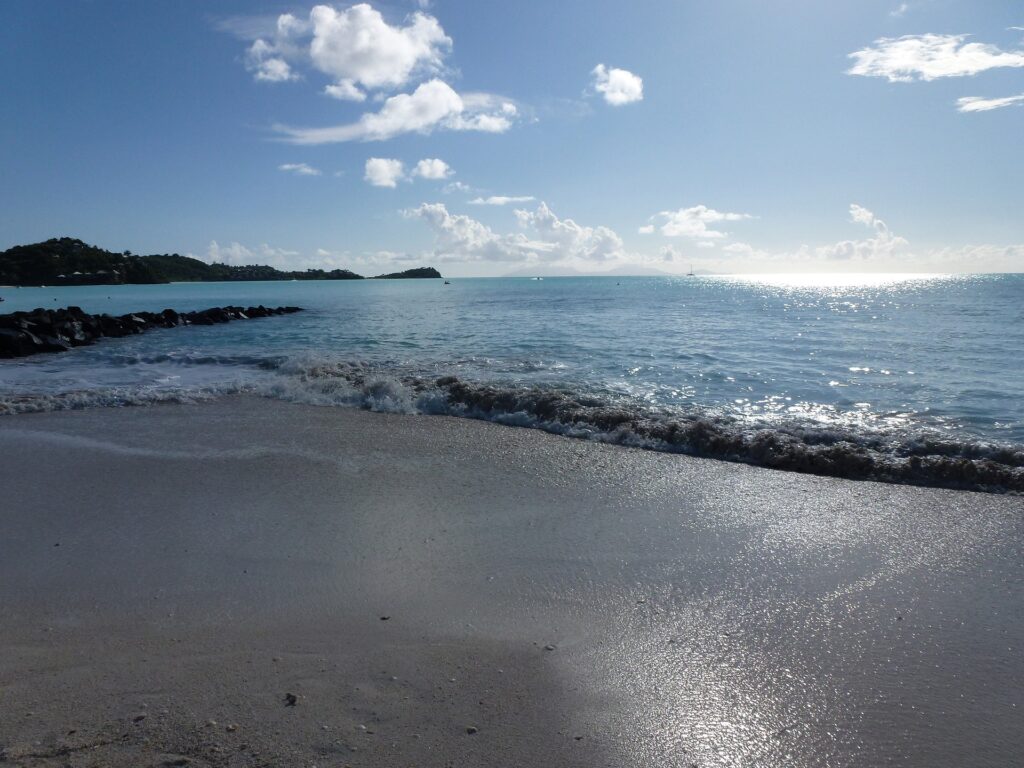
Being surrounded by water, of course, seafood is a big part of the diet. Lobster, crab, and conch figure into dishes when available, but preserved salted fish is also important to the diet. As is corn, rice, tropical fruit, and sugar!!
Some of the other interesting dishes that are screaming out to be tasted include macaroni pie, butter bread, and goat water (yes, goat water!)
I really could have picked any of these to cook and I would have been happy. But I narrowed it down to three!
ANTIGUAN AND BARBUDAN FOOD IN NEW YORK
THE VIDEO
Three dishes? No problem. I’m sure that’s what most people from Wadadli (the nickname for Antigua and Barbuda) would think about these three breakfast staples. But it was a bit of an undertaking for us.
As you will see, this was quite a project. Sam complained that it was taking too long (it was), but he also really wanted to get the coconut open with me. Not matter how long it would take.
Amazingly, it all came together in time for dinner, but Sam had some struggles about trying the food he created. He especially wanted to eat some of the ingredients that were not meant for eating. Be sure to check it all out above.
THE DISH(ES)
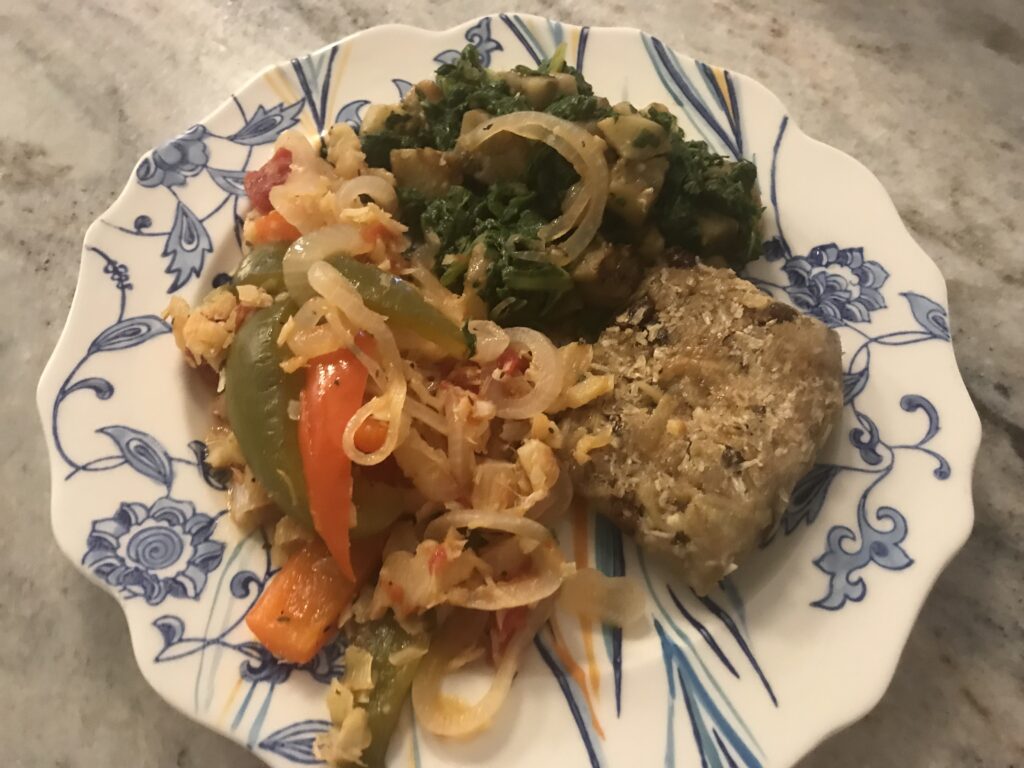
We decided for the first time to not make the National Dish of this country. We did something similar to fungie last week with Angola and we have had enough of heavy meat stews (which is what Pepperpot is). So we’re going lighter and more tropical.
I guess you could call this plate Antiguan breakfast. Just like when you go to an American diner and order the Breakfast Plate (or some similar name), you know mostly what to expect.
I am one who is happy to eat an omelette (or even pancakes) at dinnertime, so why not put this on the table?
This is also a popular combination on Good Friday, when many Antiguans don’t eat meat. We cooked this on a Friday, and even though we’re not Christian, we’ll go with it!
The main protein here is saltfish, also known as dried salted cod (sometimes other fish are used). This dish is both the name of the dish and of the ingredient (not so different from Algerian couscous in that way). There are definitely other recipes that utilize saltfish, but this is what most people expect.
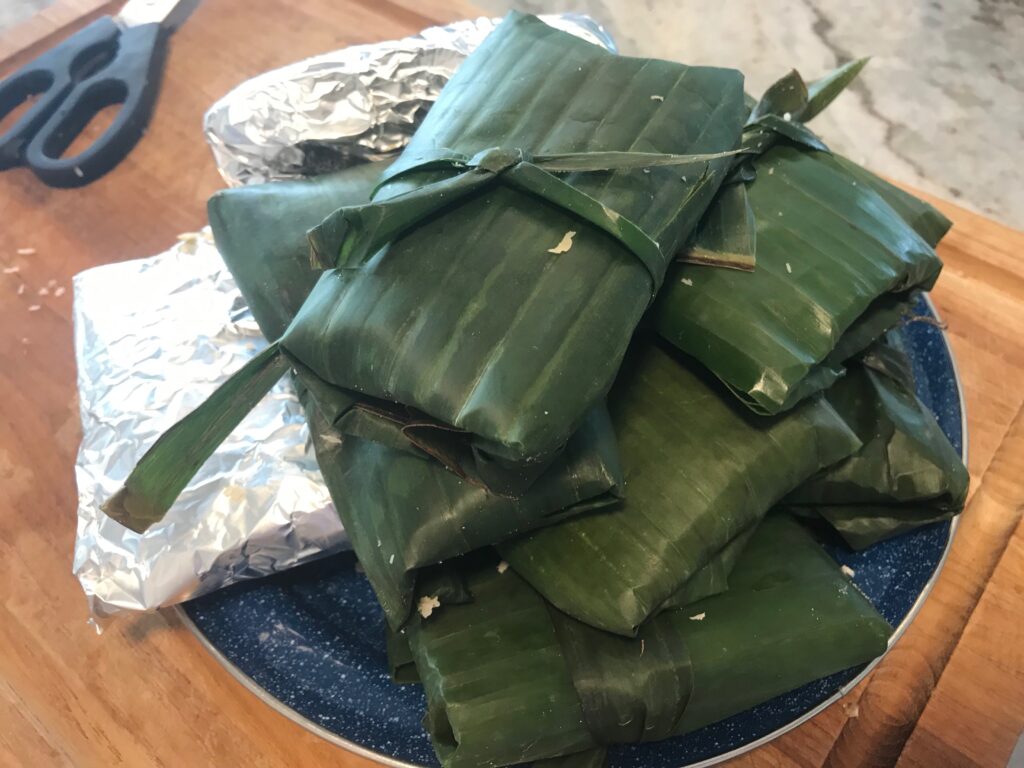
You certainly find saltfish all over the region (from Jamaica to Trinidad) but ducana seems to be a bit more specialized. From my research, Antigua is most associated with Ducana, but you can also find them on St. Vincent and the Grenadines.
Ducana no doubt is influenced by a cornmeal pudding from Ghana called dokono (or kenke).
It’s essentially a sweet potato dumpling that is cooked in the same manner as a tamale. While tamales are wrapped in a corn husk, ducana are wrapped up in a banana leaf and boiled. It’s a bit unusual sounding, but is incredibly delicious. The sweetness of the dumpling contrasts with the salty savory saltfish very well.

Debates over what to put inside the dumpling abound. Everybody agrees on sweet potato, coconut, and brown sugar, but others add pumpkin, ginger, cinnamon, and maybe raisins. Just like with rice pudding or bread pudding, the idea of raisins is very divisive. Poor raisins. They can’t get a break!
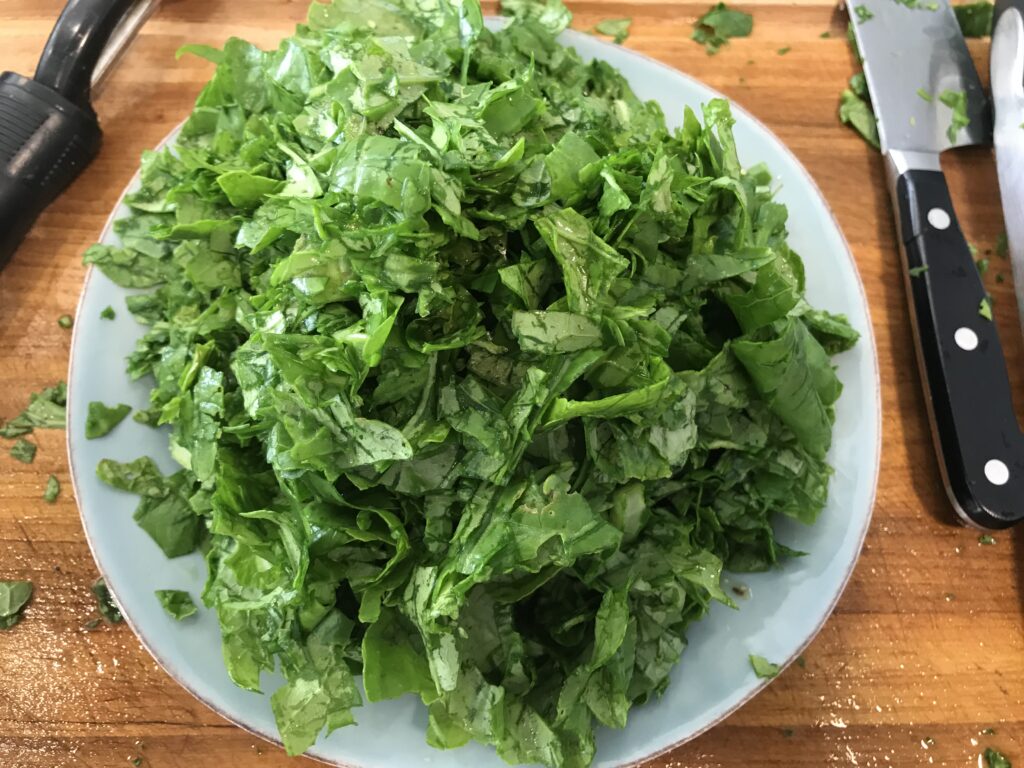
And probably for a bit of good health, we have chop-up. Just as the name indicates, vegetables are softened and chopped up into a mash. Hearty greens like callaloo or spinach are the base and then the other vegetables could be eggplant, squash, okra, onions, or just about anything else that softens that you can get your hands on. I had some beautiful greens from our CSA so decided to use those.
The crazy thing is there really are two other dishes I could have included on this plate that would have made sense at an Antiguan breakfast. Fungee is hugely popular and related to last week’s Angolan side dish of funje. In Antigua and Barbuda, it’s made from cornmeal and okra.
You also could probably find a side of Johnny cakes, orbs of fried dough, not so different from pancakes or doughnuts. I thought about making all five dishes, but then I’m positive dinner wouldn’t have been ready until breakfast (which would have actually been appropriate)!
SPECIAL INGREDIENTS
This might be my favorite part of this whole experiment. Tracking down and working with special ingredients is very exciting to me. And it gives this project an air of authenticity, doesn’t it? Doesn’t it?
It’s also interesting because I could have found these at a local Asian, Portuguese, or Caribbean Market. I actually found them all at a West Indian store who thankfully had some salted cod in the back freezer. The owner was pretty emphatic about the quality of it. Wish he could have said the same for the sweet potato I
Salted Cod
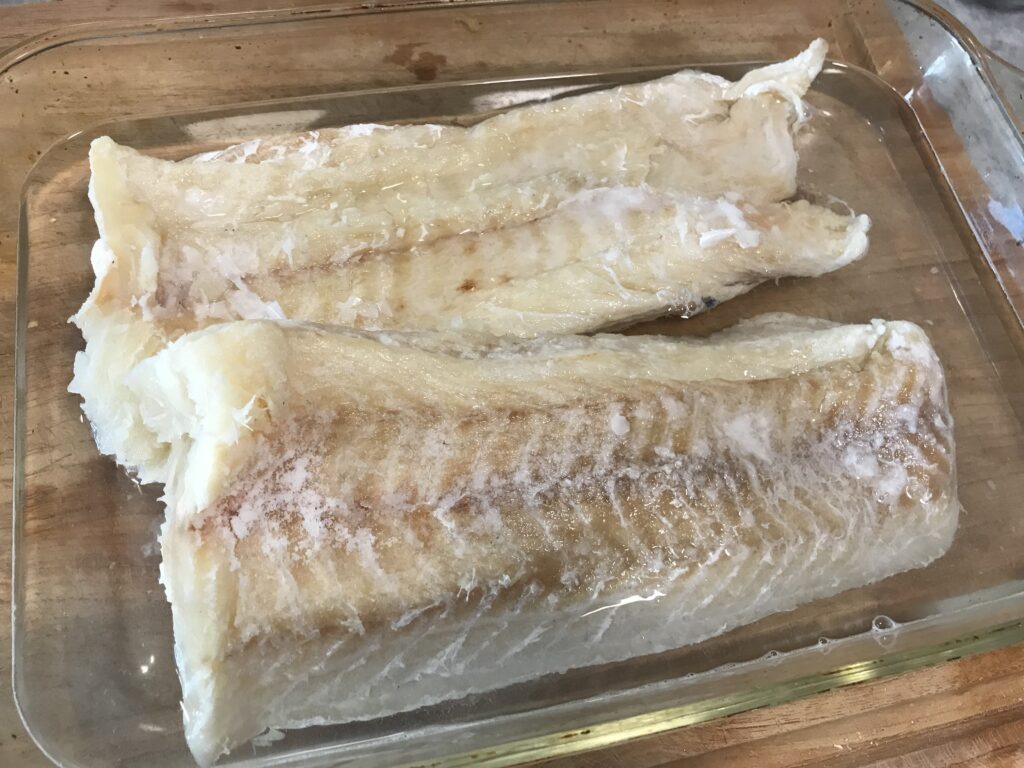
Having visited Portugal many times, I was pretty familiar with salted cod. But I have never ever cooked with it (or even had it in my apartment) until now. This was super exciting.
Salted cod is just what it sounds like. It is dried and heavily salted cod. It’s also rather hard and doesn’t even resemble food for some people. I imagine many would look at it and think, “How do I even eat this?”
Well, the key is you must dehydrate it by soaking it in water at least overnight. Even then, you need to change that water many times, rinse it well to remove most of the salt, and then boil it.
I suppose you could make this recipe with fresh or frozen cod, but it just does not come close to resembling the flavor or texture of saltfish. I mean, it’s right there in the name.
Banana Leaves
Banana leaves are humongous. You have to be prepared for that. I was able to find them frozen at my local Asian supermarket and folded over themselves.
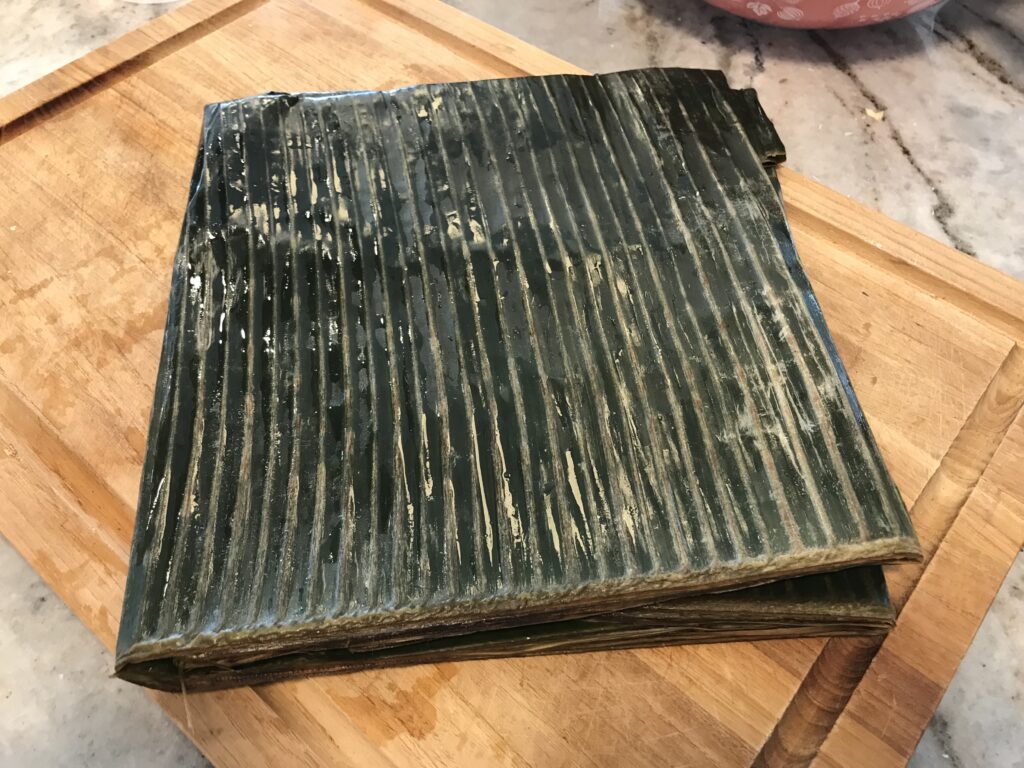
They are not the easiest ingredient to work with mostly because of their size. Be sure to cut them into much smaller pieces and wash them well to remove all the dirt.
I also learned a trick that you could heat them up over an open flame to dry them a bit and make them more flexible. It worked well for me.
And be sure not to eat these. Sam was dying to try them, which I applaud. I want to encourage him to try everything except for the things that are not edible. Like banana leaves.
If you can’t get your hands on these you can always wrap the ducana in aluminum foil.
White Sweet Potatoes

I was very excited to find these special white sweet potatoes at the West Indian market. I believe they were boniato, which is the type used for ducana. They were a bit different than the red skinned white sweet potatoes I have used in the past.
I bought two big ones, but unfortunately only one was usable. As you’ll see in the video, when I cut into one it was all brown inside and had a distinct aroma of rum. Rum is nice and all, but I think it meant this potato had begun to ferment. So while the effects might have been fun, I didn’t want to take any chances.
Pretty sure what happened is that this potato was stored just outside the market on a produce stand and it had rained quite a bit the past few days. Water and sugar equals fermentation.
You can use the more common orange sweet potatoes if you prefer but these gave it a very distinct flavor which gave me some serious island vibes. The rum would have as well!!
THE RECIPE
This is not a quick recipe. I suppose if you’re used to making this for breakfast, you get pretty good at it or you start the night before. But as I put it together, the prep work takes quite a while. But I assure you it is worth it.
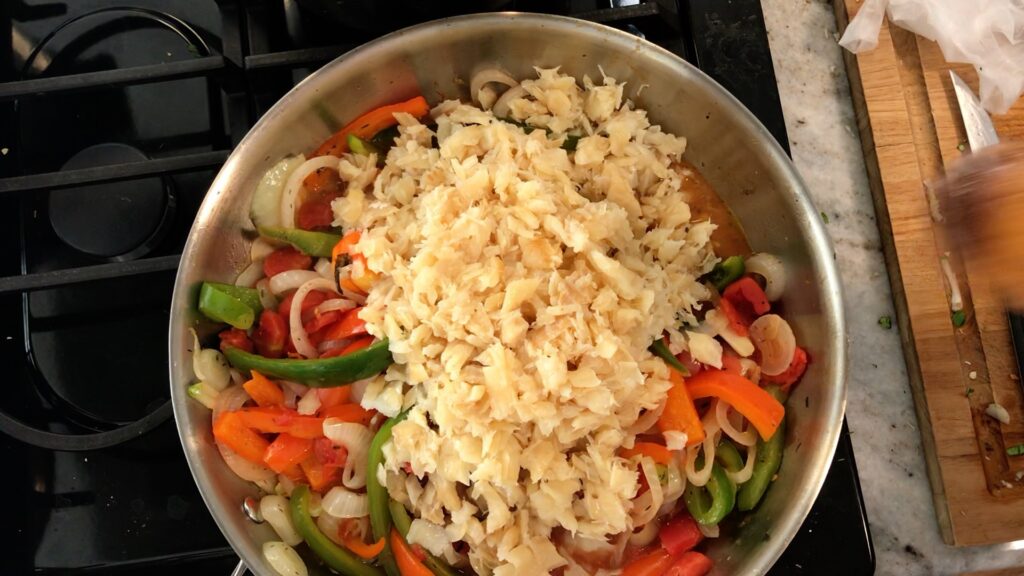
The recipes for saltfish are pretty much the same from what I discovered. Again, you need to start the process with the fish at least 24 hours before you start preparing it. But once you shred it, it’s rather simple to fry it up with colorful vegetables and spices.
Ducana definitely varies and I pulled from a number of sources. Basically, I added in what I like to eat. So yes, raisins made it into this recipe. Feel free to leave them out. Some Antiguans seem to hate the idea of raisins.
And finally, chop-up is another one that uses whatever vegetables you have around. Just make sure something is green in there.
Saltfish, Ducuna, and Chop-Up from Antigua and Barbuda
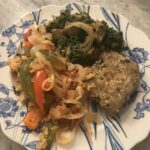
This combination of three dishes is perhaps the most iconic breakfast on the Caribbean islands of Antigua and Barbuda. A salty chewy stir-fry of fish and vegetables plays nicely off the sweet potato dumplings and a side of hearty mashed up greens and veggies.
Saltfish
- 1.5 pounds dried and salted cod (soaked in water overnight)
- 1 tbspn olive oil
- 1 yellow onion (medium)
- 2 peppers (can be green, red, or combo) (sliced into strips)
- 2 garlic cloves (sliced thin)
- 1 tbspn dried thyme
- 1 cup tomatoes (diced)
- 2 tbspn apple cider vinegar
- 1 tbspn butter
- 1 hot pepper (scotch bonnet or something else) (pierced throughout with a knife)
- 1/2 tspn black pepper
Ducuna
- 1.5 cups flour
- 1 tspn cinnamon
- 1/2 tspn nutmeg
- 2 white sweet potatoes (peeled and grated)
- 2 cups coconut (grated)
- 1/2 cup raisins
- 1 cup brown sugar
- 1 tspn vanilla
- salt
- 8-10 banana leaves (or aluminum foil)
Chop-Up
- 1 bunch hearty greens like spinach or calalloo
- 1 eggplant (peeled and cubed)
- 1 onion (chopped)
- 1 tbspn olive oil
Saltfish
-
Be sure to soak the salted cod overnight. Change the water every few hours.
-
Add the fish to boiling water and boil for 45 minutes.
-
Drain the water and pour cold ice water on fish to cool it down.
-
Once cool, drain from the water and remove bones breaking apart the fish pieces with your fingers.
-
Heat olive oil in frying pan over medium high heat. Add sliced onions, peppers, garlic, and thyme. Stir until translucent.
-
Add diced tomatoes, apple cider vinegar, butter, hot pepper, and black pepper and continue to saute. Add shredded fish and lower heat. Cook for 5-7 minutes, stirring occassionally.
Ducuna
-
Wash banana leaves well and dry thoroughly. If you're feeling brave, you can quickly heat the banana leaves over an open flame to dry and stiffen. This makes them easier to work with. Be sure to constantly move the leaf over the flame to prevent burning or flames.
-
Mix flour, cinnamon, nutmeg, and pinch or two of salt. Add grated sweet potatoes, coconut, sugar, raisins, and vanilla. Mix very well.
-
Spoon mixture carefully onto a 5 inch square of banana leaf. Wrap up tightly and tie closed ensuring there are no open areas. Alternatively, you can use aluminum foil.
-
Boil large pot of water and add dumpling. Cover and steam for 45-60 minutes.
-
Be sure to let cool slightly before you unwrap and enjoy the insides.
Chop-Up
-
Chop greens well. Add to boiling water and cook until wilted. Drain and season with salt and pepper. Set aside.
-
Heat olive oil over medium heat and sautee onion until softened. Add eggplant cubes and season with salt. Cook stirring often until eggplant becomes mushy. Season and add greens. Stir all together.
HOW I SCREWED IT UP
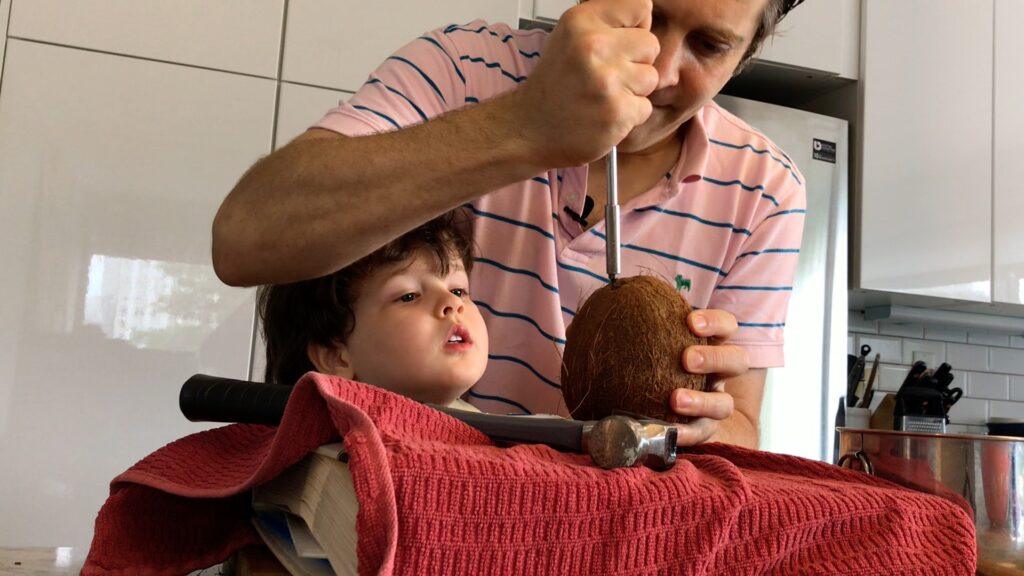
My biggest failing here is that I couldn’t get the damn coconut open!!
Still not sure if the coconut had gone bad (I got it from the same place that sold me the sweet potato) or I just could not figure it out. I used a hammer, screwdriver, my bare hands, nothing would work.
So we did a quick improvisation by picking a bag of shredded coconut up at the store. That might have affected the flavor a teeny bit, but I can’t imagine much. The ducana was still yummy.
Otherwise, time management was my biggest flaw, The food itself was pretty good, thank you very much!
SAM’S REACTION

When you’re three years old, freak outs happen pretty regularly. This meltdown seemed to be a spiral down from when I told him he wasn’t able to eat the banana leaves. From there, it looked as if there was no turning back.

The one saving grace was giving him the activity to unwrap the ducana. That calmed him down and once he actually put the sweet dumpling in his mouth, there was a revelation. If you watch the video, you can see he doesn’t want to admit it, but he’s pretty happy with the taste.
I knew there was no way he would even look at the saltfish or chop-up. That would have been a miracle, but trying (and liking) one of the dishes was a minor success.
NEXT WEEK
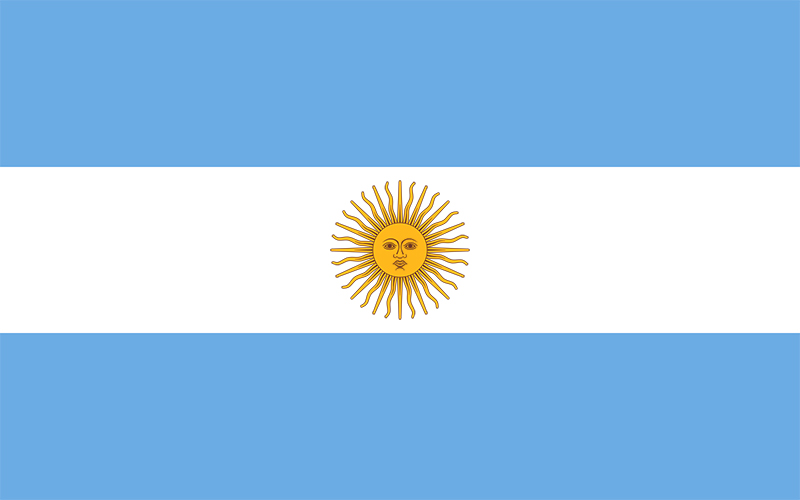
Beef is the word when it comes to our next country. The two most famous dishes from Argentina seemed a bit out of our reach, so we stuck to the beef theme and decided to prepare a hearty wintery Patagonia stew.
What would you cook from Argentina? Leave comments and thoughts below.



